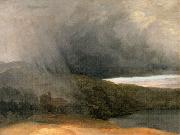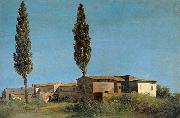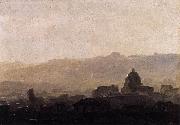Pierre-Henri de Valenciennes Olja Måleriet ReproduceringAll Pierre-Henri de Valenciennes Oil Paintings(December 6, 1750 - February 16, 1819) was a French painter. Valenciennes worked in Rome from 1778 to 1782, where he made a number of landscape studies directly from nature, sometimes painting the same set of trees or house at different times of day.He theorized on this idea in Advice to a Student on Painting, Particularly on Landscape (1800), developing a concept of a "landscape portrait" in which the artist paints a landscape directly while looking upon it, taking care to capture its particular details.Although he spoke of this as a type of painting mainly of interest to "amateurs", as distinguished from the higher art of the academies, he found it of great interest, and of his own works the surviving landscape portraits have been the most noted by later commentators. He in particular urged artists to capture the distinctive details of a scene's architecture, dress, agriculture, and so on, in order to give the landscape a sense of belonging to a specific place; in this he probably influenced other French artists active in Italy who took an anthropological approach to painting rural areas and customs, such as Hubert Robert, Pierre-Athanase Chauvin and Achille-Etna Michallon. |
|||

|
|||
|
|
|||
|
||||||||
| Pierre-Henri de Valenciennes (December 6, 1750 - February 16, 1819) was a French painter. Valenciennes worked in Rome from 1778 to 1782, where he made a number of landscape studies directly from nature, sometimes painting the same set of trees or house at different times of day.He theorized on this idea in Advice to a Student on Painting, Particularly on Landscape (1800), developing a concept of a "landscape portrait" in which the artist paints a landscape directly while looking upon it, taking care to capture its particular details.Although he spoke of this as a type of painting mainly of interest to "amateurs", as distinguished from the higher art of the academies, he found it of great interest, and of his own works the surviving landscape portraits have been the most noted by later commentators. He in particular urged artists to capture the distinctive details of a scene's architecture, dress, agriculture, and so on, in order to give the landscape a sense of belonging to a specific place; in this he probably influenced other French artists active in Italy who took an anthropological approach to painting rural areas and customs, such as Hubert Robert, Pierre-Athanase Chauvin and Achille-Etna Michallon. |
||||||||
|
|
||||||||
| Måleriet Identifieringen :: 89486 Storm by a Lake 1780(1780) Medium Oil on paper on canvas cyf |
||||||||
|
|
||||||||
| Måleriet Identifieringen :: 89502 Valenciennes 1780(1780) Medium Oil on paper on cardbord cyf |
||||||||
|
|
||||||||
| Måleriet Identifieringen :: 89755 View of the Convent of Ara Coeli with Pines 1780s Medium Oil on paper mounted on board cyf |
||||||||
|
|
||||||||
| Måleriet Identifieringen :: 89816 View of Rome in the Morning 1782(1782) and 1784(1784) Medium Oil on paper laid on board cyf |
||||||||
|
|
||||||||
|
Föregående 1 2 | FÖREGÅENDE KONSTNÄR Nästa Konstnär | |||||||
|
|
||||||||
|
Pierre-Henri de Valenciennes (December 6, 1750 - February 16, 1819) was a French painter. Valenciennes worked in Rome from 1778 to 1782, where he made a number of landscape studies directly from nature, sometimes painting the same set of trees or house at different times of day.He theorized on this idea in Advice to a Student on Painting, Particularly on Landscape (1800), developing a concept of a "landscape portrait" in which the artist paints a landscape directly while looking upon it, taking care to capture its particular details.Although he spoke of this as a type of painting mainly of interest to "amateurs", as distinguished from the higher art of the academies, he found it of great interest, and of his own works the surviving landscape portraits have been the most noted by later commentators. He in particular urged artists to capture the distinctive details of a scene's architecture, dress, agriculture, and so on, in order to give the landscape a sense of belonging to a specific place; in this he probably influenced other French artists active in Italy who took an anthropological approach to painting rural areas and customs, such as Hubert Robert, Pierre-Athanase Chauvin and Achille-Etna Michallon. |
||||||||
|
|
||||||||
|
KOMMA I KONTAKT MED Oss |









